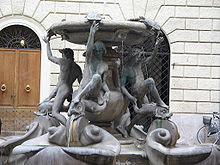Turtle fountain
The turtle fountain (Italian: Fontana delle Tartarughe ) is a fountain in Rome . It is located in the small Piazza Mattei, in the Rione Sant'Angelo in the old town of Rome. The square belongs to the Insula Mattei with the surrounding palaces Palazzo Mattei di Giove , Palazzo Mattei-Paganica and Palazzo Mattei-Caetani, which belonged to the noble Mattei family.
history
Fed by the aqueduct of the Acqua Vergine , the fountain was actually intended for the nearby Piazza Giudea, with a market. However, under pressure from Muzio Mattei, it was erected on the square in front of his palace. In return, the family undertook to pave the square and keep the fountain clean.
The fountain was built in 1581 based on a design by Giacomo della Porta . The work was carried out by the sculptor Taddeo Landini , who was supposed to create four ephebes and eight dolphins, originally envisaged in marble but eventually executed in bronze . The work was completed in 1588. Four of the dolphins were not put into operation because the lack of water pressure did not allow the intended height of the well system. These dolphins were used for the Fontana della Terrina, which was set up on the Campo de 'Fiori and was later moved in front of the Chiesa Nuova .
The turtles, which the Ephebe seem to push to the upper fountain bowl to drink, and which gave the fountain its name, were only added during the restoration in 1658, on behalf of Pope Alexander VII . They are attributed to Gian Lorenzo Bernini or Andrea Sacchi . This restoration is remembered on four inscriptions.
The fountain consists of a square basin with rounded edges, with a base made of Portasanta marble with four shells in the middle, which holds a round fountain bowl made of African marble. Under the rim there are putti heads that spit water into the fountain basin. The sculptures are attached to this architectural structure, four ephebes in the same, symmetrical pose, each with one foot on one of the dolphins and holding its tail in one hand while raising the other arm to the upper shell. Water pours out of the dolphins' mouths and is collected in the mussels.
The fountain is equipped with a water treatment system to avoid limescale deposits on the sculptures, which required frequent cleaning. In 1979 one of the turtles was stolen. The remaining three were then replaced by copies. The water treatment system was replaced in 2003 and marble and bronzes were restored from 2005 to 2006. Another renovation that cost 38,000 euros was made in 2012.
Legend
A popular legend tells that Duke Mattei, whose palace borders the square with the fountain, had the fountain built in a single day in order to impress his future father-in-law, who had strong doubts about him. The next day he summoned his fiancée and her father and let them look out a window to admire the work. Then the young duke had the window walled up so that no one else could enjoy the same spectacle, as it can still be seen today.
However, the story is unreliable because the fountain was built between 1585 and 1588, but the palace was not built until 1616.
See also
Individual evidence
- ↑ Monument Authority of the City of Rome , Italian, accessed on March 10, 2013
- ↑ Press release of the City of Rome , Italian, accessed on March 10, 2013
- ↑ Fontana Delle Tartarughe - Turtle Fountain
- ↑ Legend of the Tortoise Fountain , Italian, accessed March 10, 2013
Web links
- Description of the turtle fountain (Italian)
- Description of the turtle fountain (German)
- The turtle fountain and the surrounding palaces (English)
Coordinates: 41 ° 53 ′ 37.7 " N , 12 ° 28 ′ 39.2" E

